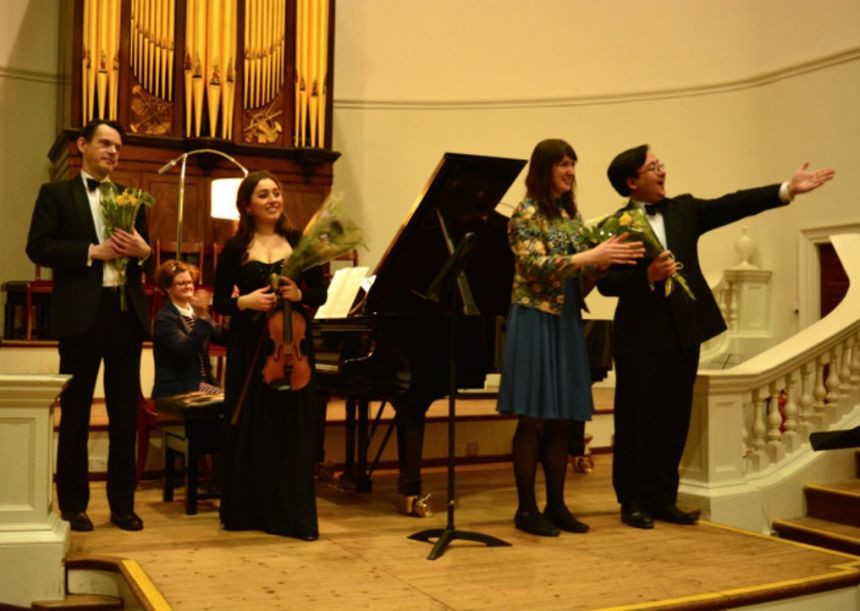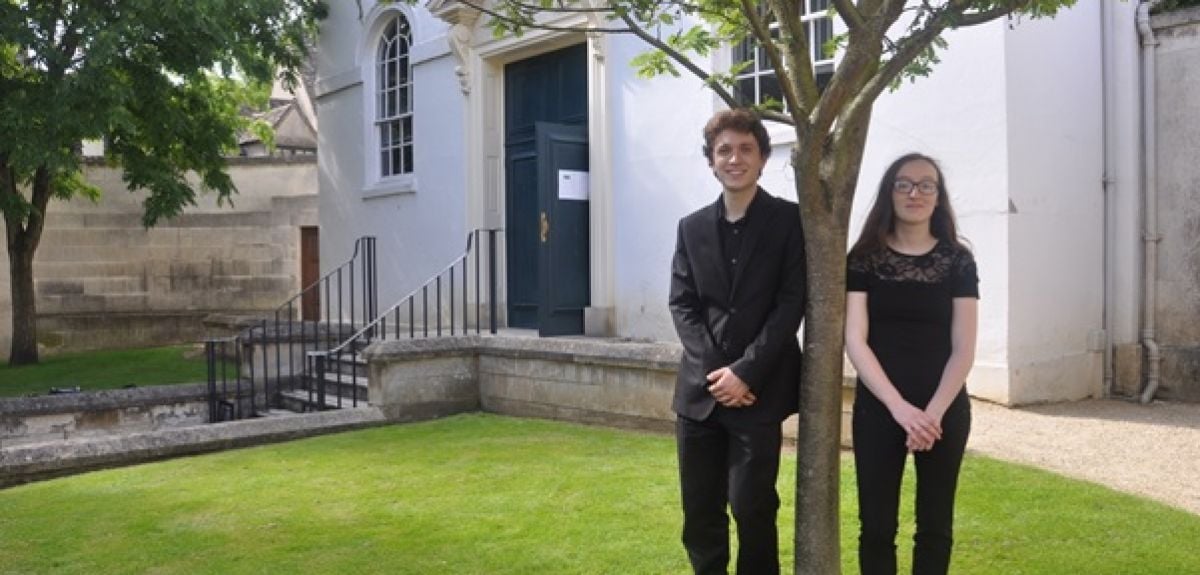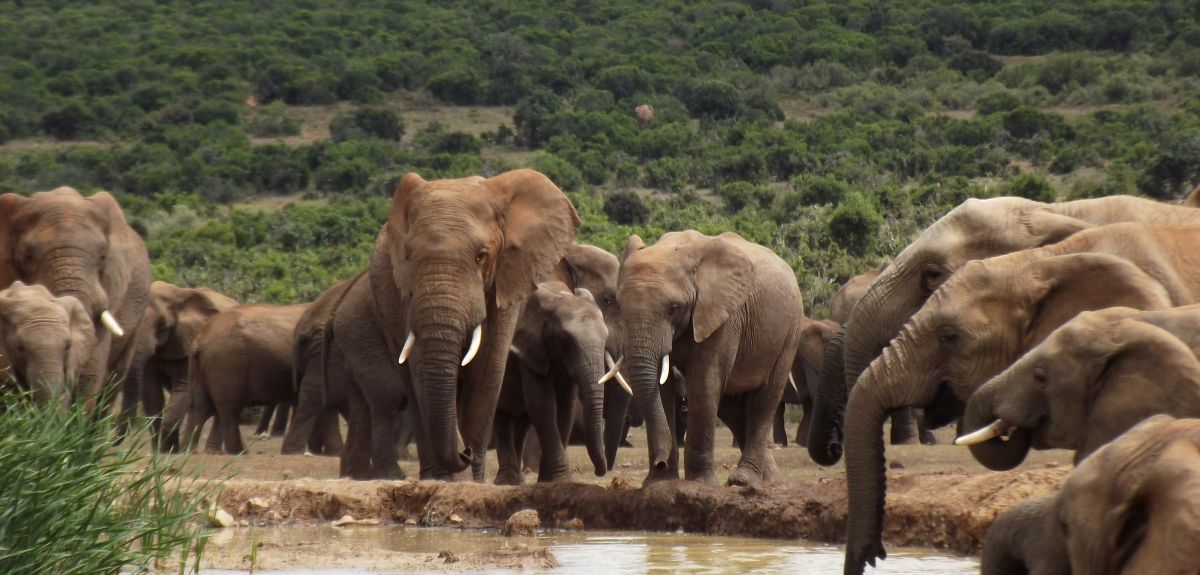Features
In the long summer vacation after the first year of his PhD, Luca Zenobi couldn’t write.
As a DPhil student, not being able to write poses a problem. Grappling for ways to kick-start himself into writing mode, Luca did what we all do when we need answers. “I Googled “how to write”,” he remembers.
When he did, Luca came across “all the usual advice,” but something stood out. “Lots of people suggested getting a group together, with writing the only thing you’re allowed to do.”
Writing groups have been springing up in Oxford - Dr Alice Kelly runs a successful one in TORCH, for example - but there wasn’t one in the History Faculty.
And Luca found that many students, like him, were struggling to get words down on paper. So, once the summer ended and October dawned, Luca set up the Oxford History Graduate Network’s writing group.
Almost two years on, Shut Up and Write (SUAW) is now a staple of postgraduate History life. After running the group for a year, Luca handed over the reins to fellow DPhil student Rachel Delman. The two have worked hard to make it as effective, and as enjoyable, as possible.
So how does it work? Twice a week, from 9am to 1pm, students meet in the Faculty. After fuelling themselves with pastries and coffee, they sit down to write for an hour at a time, punctuated by fifteen-minute breaks.
At the beginning of the session, students declare a writing goal for the day. Being accountable helps people stay on track. “I think the psychology of it really helps,” Rachel says.
Whether it’s the psychology or the pastries, something is working. The group has a keen group of regular attendees. Why do Luca and Rachel think it’s been so successful?
“A PhD can be very isolating,” Luca says. “The writing group gives people the opportunity to talk with other people doing the same thing—how’s it going? What are you working on? And then you end up discussing and sharing tips.”
But it’s not just the social element that makes SUAW so well-attended. It’s also an effective way to work. “I had times when the only proper writing I could get done was at the writing group,” Luca says.
The writing group has certainly been a blessing for students craving conversation and routine. But it’s also completely changed Luca and Rachel’s own experiences of Oxford.
As convenors, they attend twice a week, every week, providing breakfast, helping everyone set writing goals, and paying close attention to the clock.
“I’ve gained a lot of confidence from running the group, which will help in an academic career,” Rachel says.
Luca agrees, and adds, “It’s nice to know that you’re helping people out. I’ve realised that we all struggle, and that it’s fine, it’s part of the process, and talking about it is a good thing.”
Now in the later stages of their doctorates, Rachel and Luca are stepping back from the group at the end of this academic year. But they’re proud of what it’s achieved. “It’s built a community in the Faculty that wasn’t really there before,” Rachel says.
Do they have any advice for their successors? Rachel thinks about it. “Just keep buying pastries!”
Next week, Bethany will try the writing group herself and review it for Artistic Licence. But if it doesn't work, there may not be a blog next week...
What does moonlight sound like? How can a violin ‘murmur like perfume’? And what do you think ‘a bird abandoned by its companion’ would sound like on the piano?
These might not seem like obvious questions you’d encounter in a French class. But Dr Jennifer Rushworth, Junior Research Fellow in Modern Languages, and a group of undergraduate students, spent a year thinking about the answers.
As part of a year-long project, Dr Rushworth and the students turned a completely imaginary piece of music, described in French, into a real concert, performed by professional musicians.
The imaginary piece of music comes from Marcel Proust’s In Search of Lost Time, a seven-volume novel that’s one of the most well-known works of French literature.
In the novel, the main character is obsessed by a piece of music by a fictional composer called Vinteuil. Proust describes the music—but using almost no technical language. We don’t know what notes to play, but we do know that the music sounds as ‘soft as silken scarves’.
Dr Rushworth, who teaches Proust to undergraduates, had often wondered what this music might sound like. Last May, with funding from the John Fell OUP fund, she decided to find out for herself.
The first step was translating the descriptions into English from the original French.
Dr Rushworth and twenty-four undergraduate volunteers translated thousands of words of French musical descriptions into English. For the students, it was a fitting way to test their translation skills.
Next, Dr Rushworth handed over the translations to two undergraduates in Music. Together, they worked to translate the text for a second time—this time, from plain English into a musical score.
Finally, the composers handed their pieces over to professional musicians, who played the music at a concert in the Holywell Music Room on 5th May.
And, just like that, sentences written in French almost a hundred years ago became music swelling to fill a music hall in 2017.
Why, as a linguist, did Dr Rushworth want to make the music come alive? “I wanted to see if you could take text as a recipe for writing music,” she says.
She was also interested in how different people might read the text in different ways. So, for example, would a French reader interpret the music differently to an English reader, or a music student to a languages student?
But creating imaginary music also comes with uniquely high expectations. “Part of the point of Proust’s imaginary music is that, because it’s imaginary, it’s perfect,” Dr Rushworth explains. “Everything that’s real is disappointing.”
So what does Proust’s imaginary music like? Is it disappointing?
Not for Dr Rushworth. “I wasn’t disappointed,” she says. “I thought it sounded amazing.”
Although she’d worked on the project for a year, she had to wait until the day of the concert to hear the final result. Seated in one of the oldest public music halls in Europe, the music finally washed over her—and the violins murmured, like perfume.
Curious? You can listen to the music for yourself here.
 The performance itself
The performance itself
Professor Peter Magill, Deputy Director of the MRC Brain Network Dynamics Unit at the University of Oxford, gives his account of a week of science and policy in Westminster as he began his participation in The Royal Society’s Pairing Scheme.
Once a year, around 30 scientists are paired up with UK parliamentarians and civil servants by the Royal Society, to foster interactions and mutual understanding between researchers and policymakers. Over the ‘Week in Westminster’, the scientists take part in workshops focused on the interface of science with policy, and spend two days shadowing their pair in government. In turn, parliamentarians and civil servants experience the world of research through undertaking reciprocal visits to the scientists’ institutions.
I was fortunate to be given the opportunity to take part in this year’s Scheme. After an introductory tour of the Palace of Westminster on the first day, we got straight down to business in the impressive Portcullis House. After hearing from expert speakers working in academia, learned societies and government, we examined and discussed several topics that are close to many scientists’ hearts; investment in Research & Development, the recent Higher Education and Research Act, and the routes by which researchers can feed into policy making. This was especially well timed, given the publication in November of the Government’s white paper on Industrial Strategy. In just a few hours, we gained some indispensable insights into how science can - and does - inform policy, and vice versa.
On days two and three we visited our pairs at their workplaces. I was paired with Lord James O'Shaughnessy, Parliamentary Under Secretary of State for Health (Lords). I was invited to shadow Lord O'Shaughnessy and his team for many of their daily engagements at the Department of Health, the House of Lords and further afield, including policy briefings, strategy meetings, and a keynote speech. I got to see first-hand the nuts and bolts of Parliamentary business, and how evidence is gathered and used by policymakers to shape their decision making.
I also had the chance to share our own neuroscience research at Oxford, and to explain how we conduct our research, its potential impact on healthcare, and the challenges we have met (and will face in the future). As a memorable conclusion to my shadowing experience, I found myself sitting in on live questions in the chamber at the House of Lords - to see democracy and policy in action and on centre stage was thrilling. I then raced through the Victorian splendour to attend a Mock Select Committee for scientists, another highlight of the week.
The Scheme was rounded off by a morning at the Department for Business, Energy & Industrial Strategy, where we heard from teams at the Government Office for Science, and then had a Q & A session with Professor Chris Whitty, Interim Government Chief Scientific Adviser. What a week!
My time in Westminster was an extraordinary and invaluable experience. It was highly informative and empowering, and - just as important - really enjoyable. I have taken away a fresh perspective on how research findings can help inform the creation, scrutiny and revision of policy, as well as a better understanding of how researchers can get involved in the process. I was also struck by the openness, veracity and multitasking of my hosts working in government. There were many lessons learned in this short period of time, and I have no hesitation in strongly recommending the Pairing Scheme to other scientists and policymakers.
The issue of whether ivory trading should be legalised to fund elephant conservation, or banned altogether, is long standing and widely debated. Both sides of the argument are so contentious that emotional investment can distort our understanding of the core issues.
Hoping to restore some balance to the conversation, Professor EJ Milner-Gulland, Tasso Leventis Professor of Biodiversity in Oxford’s Department of Zoology, outlines both sides of this complex debate. She warns that the continued policy stalemate and intense media interest are inflaming the issue and harming the conservation of iconic, endangered species in the process.
The conservation of wildlife is complex and often contested, particularly when the species concerned is large, charismatic, with monetary value, and whose presence in an area can cause major direct impacts on people's lives. Such is the case for Africa's elephants, but it is true for other species as well, including big cats, large ungulates (hoofed mammals) and wolves. Conflicts over how to manage these species are widespread and challenging to resolve.
In particularly high profile cases, the public debates around these conflicts can become very heated and emotional.
In the case of elephants, heavy poaching in some African countries has caused deep concern for the species' future, and a range of approaches to addressing this poaching has been put forward and strongly championed by different groups. These range from complete trade bans (e.g. Born Free's Bloody Ivory campaign) to limited sales of confiscated ivory (e.g. as proposed in 2016 by Zimbabwe). The confrontational nature of the discourse is clear when observing the media furore that surrounds international meetings where the ivory trade is discussed, particularly the triennial meetings of the Conference of the Parties to the Convention on International Trade in Endangered Species (CITES), the most recent of which was in September 2016. This debate is heavily fuelled and mostly carried out by campaigning conservation organisations. In the heated atmosphere, the underlying values and motivations of those holding different views are questioned, sometimes destructively, and evidence is often interpreted and deployed in a strategic or partisan way.
Issues like elephant poaching for ivory will always rouse an emotional reaction, and rightly so. However the threat from poaching does need to be set within the wider context of issues such as loss of habitat, connectivity, food and water resources, which also threaten the future of African elephants.
This is not helpful either for elephant conservation, or for the governments of countries where elephants live, who are trying to manage their elephant populations under difficult circumstances and with limited resources.
Meanwhile, for more than two decades, African countries have been sharing views with one another and gaining mutual understanding through a series of dialogues. Over the years, supported by CITES, they have worked to develop and adopt two unique and extensive monitoring programmes (Monitoring Illegal Killing of Elephants and the Elephant Trade Information System, MIKE and ETIS) which provide information to CITES Parties about elephant killing and ivory seizures. These two systems, as well as the IUCN SSC African Elephant Specialist Group’s African Elephant Database (AED, where information on the numbers and distribution of African elephants is stored), have provided the information underpinning conservation policy-making. Building on this information, range states worked together to develop and implement the African Elephant Action Plan, which prioritises conservation actions, recognising and respecting the very different circumstances in different parts of the continent.
Despite this huge investment of time and resources into elephant conservation, poaching continues, public concern remains high, and the best way forward is highly contested, particularly in the international media.
An important component of successful conflict negotiation, whether in conservation or other fields (such as national peace processes or climate negotiations) is to hold discussions of the main affected parties away from the glare of the media. such as the African Elephant Range States dialogues. In other fields (particularly fisheries management), these discussions have included the use of formal structured decision-making processes such as Management Strategy Evaluation. These processes go a step further than is currently done in species conservation (including for Africa's elephants).
For elephants, this would start with the agreed goals and priorities of the African Elephant Action Plan. Then researchers would compile and assess all the evidence that exists about elephant poaching and ivory trade, including the existing databases like MIKE, ETIS and the AED, but also local studies of poaching behaviour and consumer demand. This would help us to understand what the uncertainties and knowledge gaps are. Next, this evidence-base can be used to build and test computer simulation models, to explore the conservation outcomes of different potential policy options, at different scales from the local management of Protected Areas in Africa, to initiatives that aim to change consumer preferences in Asian countries. The questions to be addressed would be decided by the African elephant range states, with scientists acting as facilitators and technical support, rather than initiators. When used in this way, structured decision-making processes have already proven to be effective at reducing negotiation times and conflict, and improving conservation and livelihood outcomes, in a variety of contexts. But they have yet to be tried in species conservation.
In a paper published today, my colleagues and I suggest that it would be worth exploring whether following a formal decision-making process would be useful for African elephant conservation. Using these methods could clarify the likely consequences for elephant conservation of contentious policy questions such as the burning of ivory stockpiles, allowing limited legal trade, or closing domestic ivory markets.
It would also clarify where we need to do more research, if we can’t predict the consequences of particular actions based on what we already know.
We also highlight the importance of understanding and respecting the values held by people who see things differently, and recognising that these values may inform the way in which evidence is viewed and interpreted, sometimes subconsciously. Starting from a position of openness and respect for others' dilemmas is an important part of building trust and moving any debate onto a more constructive footing. This message is aimed more at campaigning international conservation organisations than at those already engaged in elephant management on the ground, who are generally well aware of the challenges and trade-offs inherent in real-world conservation.
Issues like elephant poaching for ivory will always rouse an emotional reaction, and rightly so. However the threat from poaching does need to be set within the wider context of issues such as loss of habitat, connectivity, food and water resources, which also threaten the future of African elephants.
Donors need to continue to support dialogue among the range states and the further development of databases such as MIKE, ETIS and the African Elephant Database. They need to also support efforts to better forecast and plan in an era of rapid land transformation and resulting habitat loss across Africa. With the added elements we suggest in our paper, we hope the unconstructive public debates which rage around the issue could be dampened down. This would ultimately benefit the conservation of Africa's elephants. Most species do not attract the huge media attention that elephants do, but they too could benefit from the approaches we lay out in our paper. These are already well-used in other fields (like fisheries management and climate change) where similarly difficult decisions need to be made, despite not having all the facts, and where the people involved may have very different perspectives and interests.
Professor Chas Bountra, Co-Director of the Oxford Martin Programme on Affordable Medicines and Chief Scientist at the Structural Genomics Consortium, explains why a new approach to drug discovery and development is needed to address the urgent need for new drugs.
Pharmaceutical research and development (R&D) is one of the best examples of human ingenuity. It attracts vast amounts of funding, employs brilliant minds, and deploys the most advanced technologies. Over the past century, it has enabled unprecedented advances for human health.
Yet the pharmaceutical R&D system is struggling to keep up with society’s medical needs. High failure rates and prolonged research timelines for candidate drugs constitute a human tragedy, and have dramatically increased the cost of drug discovery over the last decades.
More and better medicines are desperately needed at a time of global ageing and expanding populations, with new challenges such as antibiotic resistance on the horizon and many tropical infectious diseases still in need of adequate pharmaceutical solutions. To meet these challenges it is imperative that we rethink drug discovery.
In a new study, ‘A New Pharmaceutical Commons: Transforming Drug Discovery’, I and my colleagues, Dr Wen Hwa Lee, and Dr Javier Lezaun, call for ‘open science’ approaches to drug discovery and offer ways forward that would transform how the medical challenges of this century could be addressed more efficiently.
Our research highlights the limits of traditional R&D models focussed on secrecy and the protection of Intellectual Property (IP) rights, and offers a set of recommendations for strengthening pre-competitive and open source practices that can accelerate the race for cures to the world’s most harmful diseases.
The pharmaceutical industry has made enormous strides in the production of potential therapies and medicines. But even today, close to 90% of candidate drugs that enter Phase 1 trials fail to make it to the market place. This is a system beset by duplication of effort and hence wastage of resources. No one lab or institution can do this on its own. We must urgently pool resources and expertise, minimise duplication, explore new drug targets, biomarkers, and technologies in order to generate new, effective, and more affordable drugs for patients more quickly.
The new paper calls for the adoption of ‘open science’ principles that would allow for a less restrictive approach to the sharing of pharmaceutical tools and data, and would re-define the role of IP in pharmaceutical R&D. It also gives examples of where this is already working successfully.
There has been a great deal of successful experimentation with the application of pre-competitive and open source approaches to drug discovery, not least here at Oxford with the Structural Genomics Consortium, which has shown how corporate pharmaceutical resources can be pooled and used to produce IP-free science.
Our study identified a number of ways in which the world of drug discovery can be enlarged and strengthened, including:
- tax incentives for pre-competitive and open source research, for example by introducing a lower tax rate on profits obtained from IP-free innovations, or to facilitate the placing of patented innovations in free-access platforms.
- the introduction by regulatory agencies of specific designation for products developed through open science collaborations, with reduced fees and fast-tracked review of technical data.
- the development of new evaluative metrics by pharmaceutical companies to better capture the value of open science research, and create schemes that allow researchers to contribute a percentage of their time to open science drug discovery initiatives.
- a shift away from patent- and intellectual property-centric measures of performance within academia.
- increased investment in open science drug discovery initiatives by research funding bodies, to develop specific funding programmes to kick-start these efforts and place the supporting infrastructures on more sustainable footing.
Although there is no simple one-size-fits-all solution to the challenges of the drug discovery process, open source R&D has the potential to have a significant impact.
The full paper, ‘A New Pharmaceutical Commons: Transforming Drug Discovery’, can be read on the Oxford Martin School website.
- ‹ previous
- 80 of 248
- next ›





 Teaching the World’s Future Leaders
Teaching the World’s Future Leaders  A blueprint for sustainability: Building new circular battery economies to power the future
A blueprint for sustainability: Building new circular battery economies to power the future Oxford citizen science project helps improve detection of antibiotic resistance
Oxford citizen science project helps improve detection of antibiotic resistance The Oxford students at the forefront of the fight against microbial resistance
The Oxford students at the forefront of the fight against microbial resistance  The hidden cost of AI: In conversation with Professor Mark Graham
The hidden cost of AI: In conversation with Professor Mark Graham  Astrophoria Foundation Year: Dr Jo Begbie reflects on the programme’s first year
Astrophoria Foundation Year: Dr Jo Begbie reflects on the programme’s first year World Malaria Day 2024: an interview with Professor Philippe Guerin
World Malaria Day 2024: an interview with Professor Philippe Guerin From health policies to clinical practice, research on mental and brain health influences many areas of public life
From health policies to clinical practice, research on mental and brain health influences many areas of public life From research to action: How the Young Lives project is helping to protect girls from child marriage
From research to action: How the Young Lives project is helping to protect girls from child marriage